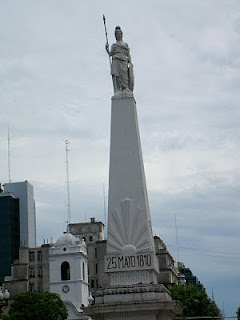
In the Salta province of Argentina, we set out to visit Bodega Colome, launching from Cafayate, the charming town where we were staying. We were about halfway there, enjoying the scenic route up through the mountains alongside the cacti, when we were faced with a choice of 2 directions to take. We opted for the "shorter" way because we were running late, but it was perhaps not the best choice. It was clearly the road less traveled, and for good reason - very narrow, rocky, sandy roads with no pavement in sight. At one point we almost got stuck in a sand ditch and had to build a rock path to drive over. We gathered rocks and Peter arranged them just so, building up the sand with 2 lanes of rocks so he could drive over the ditch. Once we built our bridge I directed him to ensure he stayed on the rock path, and after just 2 tries Peter got us out! We were so relieved. The next obstacle was a bit of mud and marsh, and again, 2 possible directions, but Peter assessed the situation and determined the best path, concluding that the mud was solid enough that we wouldn't get stuck. From here we could almost see Colome up in the hills. Then finally we made it there, 2200 meters above sea level, a mere 1 hour late for our appointment.
Thankfully, it was worth it! I really liked the wines here. The whites were flavorful and crisp. The reds were super concentrated but had really good flavors and complexity. All the wines here had a chalky minerality that we hadn't noticed in wines from Mendoza. This could be attributed to the rocky mountain soil. Colome has 2 additional vineyard sites besides the 2200m one we visited with the winery, and one of them is 3015 meters above sea level - the highest vineyard in the world, they say. The altitude helps cool things down in this very hot region of Argentina.

The wines:
*Mystery white: a mystery because the vines are so old and have morphed a few times from cloning, so they don't know exactly what they are. To me it tasted like Sauvignon Blanc, with gooseberry, asparagus, and jalapeno pepper.
*Torrontes 2009: at first vanilla and banana candy, then classic orange blossom as it warmed up in the glass. Different from the Torrontes we'd had so far, but interesting, and smooth with good acid.
*Amalaya 2007: a blend of mostly Malbec with some Cab Sauv and a little bit of something I can't remember. Cranberry and spice, good body and smooth tannin, my favorite of the tasting.
*Malbec Estate 2007: 85%Malbec, 8%Tannat, 5%Cab Sauv, 2%Syrah. Pure blackberry fruit, bright with firm tannin.
*Syrah 2007: a wine only available at the winery and served in their hotel's restaurant, it was pretty special with cassis, blackberry jam and a hint of cured meat. Firm tannin and almost 16% alcohol! A wine that should come with a 1-glass max. warning.
Colome is biodynamic and produces 900,000 liters of wine per year from 150 hectares of planted vines. All their supplies and equipment come from Mendoza, so everything makes that rocky, uphill climb through the Andes. There is a beautiful hotel on the property, and we now realize why. After all those bumps and jumps you totally want to take a nice long siesta. But our trip was just 3 hours, so we about-faced and took the road more traveled with no snafus. Muchas gracias to Peter for getting us there and back, no worse for the wear!


















